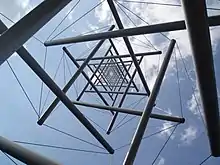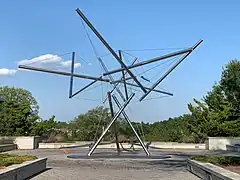Kenneth Snelson | |
|---|---|
 Needle Tower II by Kenneth Snelson (1969) at the Kröller-Müller Museum in Netherlands | |
| Born | June 29, 1927 |
| Died | December 22, 2016 (aged 89) New York City, New York |
| Nationality | American |
| Education | University of Oregon Black Mountain College Fernand Léger in Paris. |
| Known for | Sculpture, Photography |
Kenneth Duane Snelson (June 29, 1927 – December 22, 2016) was an American contemporary sculptor and photographer. His sculptural works are composed of flexible and rigid components arranged according to the idea of 'tensegrity'. Snelson preferred the descriptive term floating compression.
Snelson said his former professor Buckminster Fuller took credit for Snelson's discovery of the concept that Fuller named tensegrity.[1] Fuller gave the idea its name, combining 'tension' and 'structural integrity.' Kārlis Johansons had exhibited tensegrity sculptures several years before Snelson was even born. The height and strength of Snelson's sculptures, which are often delicate in appearance, depend on the tension between rigid pipes and flexible cables.
Biography
Snelson was born in Pendleton, Oregon, in 1927. He studied at the University of Oregon in Eugene, at the Black Mountain College,[2] and with Fernand Léger in Paris. His sculpture and photography have been exhibited at over 25 one-man shows in galleries around the world including the structurally seminal Park Place Gallery in New York in the 1960s. Snelson also did research on the shape of the atom. Snelson continued to work in his SoHo studio, occasionally collaborating with animator Jonathan Monaghan.[3] He lived in New York City with his wife, Katherine.
He held five United States patents: #3,169,611: Discontinuous Compression Structures, February 1965; #3,276,148: Model for Atomic Forms, October 1966; #4,099,339: Model for Atomic Forms, July 1978; and #6,017,220: Magnetic Geometric Building System; and most recently, #6,739,937: Space Frame Structure Made by 3-D Weaving of Rod Members, May 25, 2004.
Snelson was a founding member of ConStruct, the artist-owned gallery that promoted and organized large-scale sculpture exhibitions throughout the United States. Other founding members include Mark di Suvero, John Raymond Henry, Lyman Kipp and Charles Ginnever.
After suffering from prostate cancer, Snelson died on December 22, 2016, at the age of 89.[4]



%252C_Gro%C3%9Fe_Wallanlagen%252C_Hamburg_(1).jpg.webp) Osaka II, park Planten un Blomen, Hamburg
Osaka II, park Planten un Blomen, Hamburg "Indexer II" Sculpture, University of Michigan North Campus, Ann Arbor, Michigan
"Indexer II" Sculpture, University of Michigan North Campus, Ann Arbor, Michigan
Honours and awards
- (1999) Lifetime Achievement in Contemporary Sculpture Award, International Sculpture Center.
Sculptures in public collections and public spaces
United States
Alabama
- Mora Terry II, Birmingham Museum of Art, Birmingham
California
- City Boots, 1968, J. Patrick Lannon Foundation, Los Angeles
- Mozart I, 1982, Stanford University, Palo Alto
District of Columbia
- Needle Tower, 1968, Hirshhorn Museum and Sculpture Garden, Washington
- Untitled Maquette, 1975, Hirshhorn Museum and Sculpture Garden, Washington[9]
Florida
- Newport, 1968, M. Margulies, Coconut Grove
- Double City Boots, 1967, MDC Wolfson Campus, Miami
- X-Planar Tower, John and Mable Ringling Museum of Art, Sarasota
Iowa
- Four Module Piece, 1968, Riverfront Crossings Park, Iowa City
Louisiana
- Virlane Tower, 1981, Sydney and Walda Besthoff Sculpture Garden at NOMA, New Orleans
Maryland
- B-Tree, 1981, National Institutes of Health, Bethesda
- Easy Landing, 1977, City of Baltimore, Baltimore
- Six Number Two, 1967, Annmarie Sculpture Garden (Smithsonian partner/annex site), Solomons, Maryland
Massachusetts
- Mozart III, 2008, Science Center, Wellesley College, Wellesley,[10]
Michigan
- Indexer II, 2001, University of Michigan, Ann Arbor
- B-Tree II, 2005, Frederik Meijer Gardens & Sculpture Park, Grand Rapids
Missouri
- Triple Crown, 1991, Hallmark, Inc., Kansas City, Missouri, just north of 27th Street between Main Street and Grand Blvd, at the South end of the Crown Center complex. The sculpture consists of 30–40 aluminum tubes held together and apart by steel cables. The entire assembly is roughly 23 meters on each of three sides and roughly that tall, with the low point being roughly 5 meters above the ground.[11]
Nebraska
- Able Charlie, 1983, Joslyn Art Museum, Omaha
New York
- Coronation Day, 1980, City of Buffalo, Buffalo
- E.C. Column, 1969–81, Albright-Knox Art Gallery, Buffalo
- Four Chances, 1982, Albright Knox Museum, Buffalo
- Fair Leda, 1969, Nelson Rockefeller Estate
- Free Ride Home, 1974, Storm King Art Center, Mountainville
- Mozart II, 1982, Donald M. Kendall Sculpture Garden at Pepsico, Purchase
- Sun River, 1967, Whitney Museum of American Art, New York
- One World Trade Center antenna/spire, 2006, One World Trade Center, New York
New Jersey
- Northwood II, 1970, Compton Quad, Graduate College, Princeton, Mercer
North Carolina
- Northwood II(maquette), 1970, Asheville Art Museum, Asheville
Pennsylvania
- Forest Devil, 1975–77, Museum of Art, Carnegie Institute, Pittsburgh
Ohio
- Forest Devil, 1975, University of Cincinnati, Cincinnati
- V-X, 1968, Columbus Museum of Art, Columbus
Oklahoma
- Sleeping Dragon, 2002–03, Kirkpatrick Oil Company Building, Oklahoma City
Tennessee
- Dragon II, 2005, Knoxville Museum of Art, Knoxville
- V-X-II, 1973-4, Hunter Museum, Chattanooga
Texas
- Northwood, 1969, Northwood Institute, Cedar Hills
Vermont
- "Hard Wired", Bennington (College)
Wisconsin
- Northwoods III, 1970, Milwaukee Art Museum, Milwaukee
International
Germany
- Soft Landing, 1975–77, Berlin Nationalgalerie, Berlin
- Avenue K, 1968, City of Hannover
The Netherlands
- Easy-K, 1970, Sonsbeek ‘70, Arnhem
- Needle Tower II, 1969, Kröller Müller Museum, Otterlo
Japan
- Osaka, 1970, Japan Iron & Steel Federation, Kobe
- Needle Tower II, 1989,Shiga Prefecture Museum,Shiga
- T-Zone Flight, 1995, JT Building, Toranomon, Tokyo
- Landing, 1970, Wakayama Prefecture Museum, Wakayama
Location Unknown
- Audrey I, 1966, Private Collection
- Audrey II, 1966, Private Collection
- Equilateral Quivering Tower, 1973–92
- Tri-Core Column, 1974
- Wing I, 1992; Ed. 4, Private collection : University of Puerto Rico – Mayaguez
- Rainbow Arch, 2001
- Dragon, 2000–03
See also
- Space frame
- Kārlis Johansons, tensegrity innovator
References
- ↑ "FAQ". Kennethsnelson.net. Archived from the original on December 23, 2019. Retrieved April 20, 2021.
- ↑ "Archived copy". Archived from the original on August 21, 2012. Retrieved June 18, 2011.
{{cite web}}: CS1 maint: archived copy as title (link) - ↑ 38th Rotterdam Film Festival Shorts Program
- ↑ Kenneth Snelson, Sculptor Who Fused Art, Science and Engineering, Dies at 89
- ↑ Kenneth Snelson. "Outdoor Works". kennethsnelson.net. Kenneth Snelson. Retrieved May 26, 2021.
- ↑ "Needle tower, 1968". krollermuller.nl. Kröller-Müller Museum. Retrieved May 27, 2021.
- ↑ Kenneth Snelson. "Outdoor Works". kennethsnelson.net. Kenneth Snelson. Retrieved May 26, 2021.
- ↑ Kenneth Snelson. "Outdoor Works". kennethsnelson.net. Kenneth Snelson. Retrieved May 26, 2021.
- ↑ "Kenneth Snelson Untitled Maquette, 1975". Hirshhorn Museum and Sculpture Garden, Smithsonian Institution. Retrieved September 22, 2011.
- ↑ "Wellesley College Receives Permanent Gift of Snelson Sculpture | Wellesley College". Archived from the original on April 12, 2013. Retrieved June 12, 2013.
- ↑ This description was judged by eye from the image in Google Earth. It could be improved by closer inspection. Freedom of panorama in the United States does not extend to art work. Thus, including photos of this in Wikimedia Commons would require the permission of the owner, Crown Center. Triple Crown sculpture, Wikidata Q66839784
- Busch, Julia M., A Decade of Sculpture: the New Media in the 1960s Archived September 29, 2007, at the Wayback Machine (The Art Alliance Press: Philadelphia; Associated University Presses: London, 1974) ISBN 0-87982-007-1
Further reading
- Heartney, Eleanor, Kenneth Snelson: forces made visible/essay by Eleanor Heartney; additional text by Kenneth Snelson, Lenox, Massachusetts: Hard Press Editions, 2009.
- Sande-Friedman, Amy, "Kenneth Snelson & the Science of Sculpture in 1960s America", Doctoral Dissertation, New York: Bard Graduate Center, 2012.